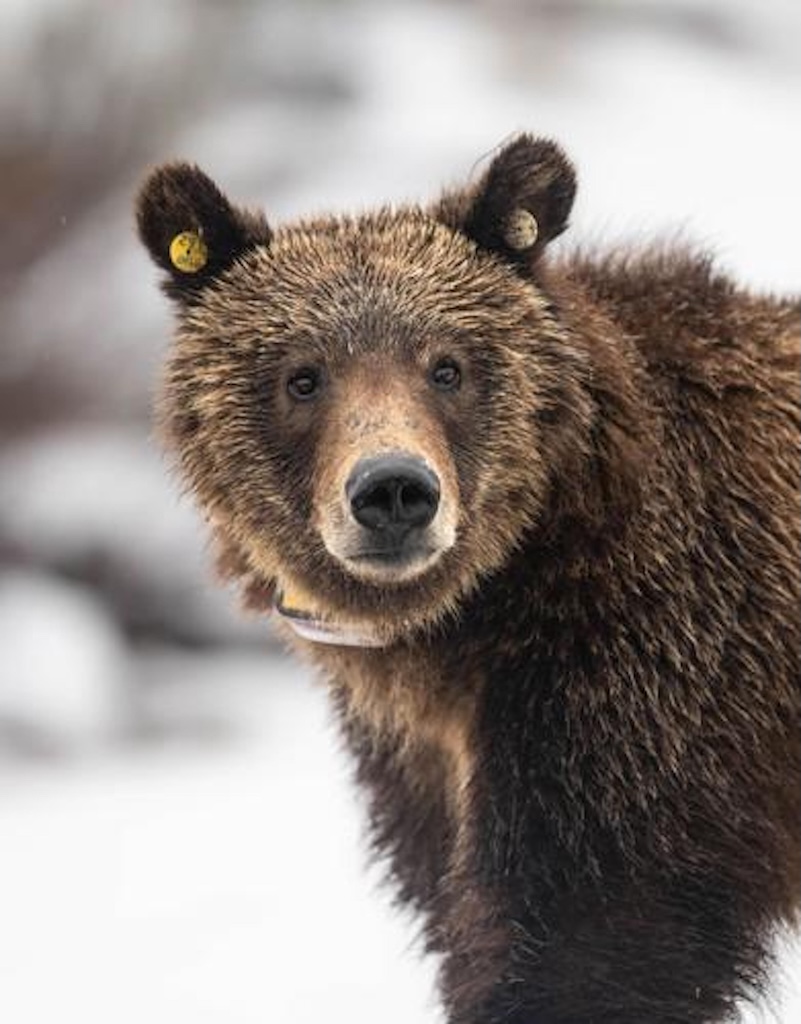Killed by car in Teton park, Grizzly 399’s offspring follows other cubs’ tragic pawprints
By Wyoming News Exchange
May 8, 2025

Grizzly 1058 on Easter Sunday 2022, the day Grizzly 399 and her four quads emerged from the den together for the last time. The five-year-old grizzly boar was apparently hit and killed by a car in Grand Teton National Park within the past week. Photo courtesy of Savannah Rose.
Grizzly 1058 dies in the same manner as his famous mother, the Tetons’ queen.
By Billy Arnold
Jackson Hole News&Guide
Via- Wyoming News Exchange
JACKSON — The news hit Jackson wildlife watchers like a ton of bricks.
Grizzly 1058, a member of Grizzly 399’s iconic four-cub litter, is dead. The 5-year-old boar apparently was killed by a vehicle on the eastern edge of Grand Teton National Park. When it happened is uncertain, but officials found the carcass Tuesday.
“I honestly feel like I got punched in the stomach,” said Savannah Rose, a photographer who chronicles Greater Yellowstone Ecosystem wildlife and advocates for grizzly bears.
Earlier Tuesday, Rose had been talking with the News&Guide about a possible sighting of another Grizzly 399 offspring, a subadult known as “Spirit” that was orphaned when 399 was killed by a motorist last year (see page 13A). Following the grizzly matriarch’s death last fall, the news about 1058’s demise stung.
“It felt like life was being breathed back into 399’s story,” Rose said, reflecting on the juxtaposition between the possible “Spirit” sighting and 1058’s death. “This is a huge blow with everything that’s happened.”
Humans have now killed two bears from 399’s infamous litter of four.
The Wyoming Game and Fish Department euthanized Grizzly 1057 in 2022 after the bear sought human food near Cora. In total, 11 of 399’s 18 cubs have died, mostly in a variety of conflicts with humans.
Grizzly 1058 is the third of 399’s offspring to be killed by a car. Grizzly 610, 399’s daughter, appeared to have been hit by a car in the Buffalo Valley area in 2023, but she walked away unscathed.
Teton park officials are investigating 1058’s recent death. It’s not clear whether the National Park Service will press charges.
“In the course of investigation, if we find sufficient evidence to pursue that law enforcement angle, we’ll certainly do that,” said Justin Schwabedissen, Grand Teton’s bear biologist. But he couldn’t say whether other wildlife-vehicle collisions had led to charges, and said sometimes accidents are just accidents.
Lincoln County deputies, for example, cleared the driver that hit 399 in October following an investigation.
Rangers found 1058’s body within park boundaries about 125 feet off Highway 26 east of the Buffalo Fork River. A law enforcement ranger on routine patrol had noticed avian scavengers — ravens and eagles — grouped up along the highway. When that officer approached the scene, they saw the dead bear and called for help, Schwabedissen said. Law enforcement was called in, as was the U.S. Fish and Wildlife Service. Grizzlies are still protected under the Endangered Species Act. (Read more about that on page 12A.)
Officials scoured the scene and performed a field necropsy on the carcass. They found blood and grizzly hair on the road, and signs of trauma on 1058’s body — signs of a vehicle strike, Schwabedissen said.
1058’s carcass was about 20% scavenged, indicating it had been there for three to seven days, he added.
In 2020, Grizzly 399 emerged from the den with four cubs, delighting hordes of bear watchers who had been cooped up in the pandemic. Biologists have counted only 10 other litters of grizzly quads since 1973 in the ecosystem — 11 if you include the first-ever litter of five seen last summer. At 0.5%, that’s a minute fraction of all the grizzly bear litters documented in the past 51 years. Even park officials were thrilled.
But over the next two and half years, 399 and her four pack lived dangerously, leaving the park and heading south into developed Jackson Hole multiple times. They waltzed past the Jackson Town Hall, got into human garbage, compost and bird feeders. To try to track their movements, and keep them away from human food, wildlife managers trapped three of the four cubs, collaring two.
1057, who was killed in Cora, was one of the collared bears. 1058 was the other.
Across the Greater Yellowstone Ecosystem, vehicle strikes are not the leading cause of grizzly bear deaths, claiming only about four bears a year. In contrast, hunters and other backcountry travelers tend to kill about 10 grizzlies a year in self-defense. In 2024, a record year for grizzly deaths in the Greater Yellowstone, more than 70 were killed across the ecosystem. Over 20 were killed due to cattle depredation, according to data from November 2024. Grizzlies, in turn, killed a record number of cattle that year.
But wildlife-vehicle collisions involving grizzlies have been highly scrutinized since 399’s death last year. The Snake River Canyon collision has spurred study of roadside bear viewing, and what it means for grizzlies. Schwabedissen said it was too early to point to any conclusions, or recommend changes as a result.
“We’re continuing to kind of study these roadside bear jams and the bears associated to learn more about that,” he said. “We’re also undergoing a comprehensive review of the bear program here at Grand Teton.”
On Facebook later Tuesday, Rose, the wildlife photographer, lamented 1058’s death. “Rest in peace 1058, son of 399, my favorite of the quads. You were so full of life and independence,” she wrote. “Cut down before your time like your mother, struck by a vehicle. 399, I am so sorry we failed you again.”
“We need to do better,” she added.

